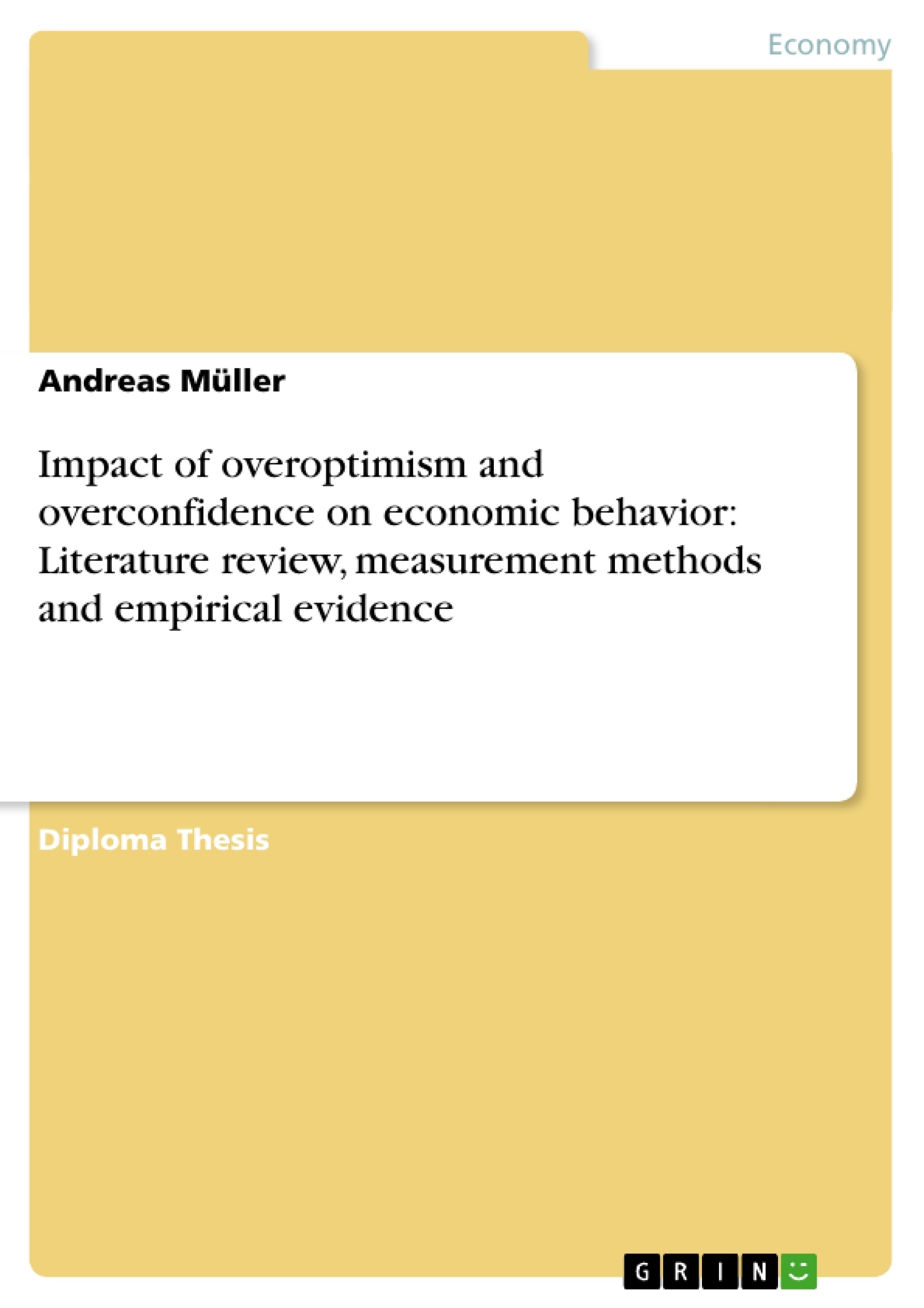This paper aims to give an overview of two related human traits that have attracted particularly wide interest, namely overconfidence and overoptimism. The two are closely related to each other, and often used synonymously. Broadly speaking, overconfidence results in underestimation of future risks, e.g. the riskiness of future cash flows, whilst overoptimism leads to an overestimation of future positive outcomes, e.g. the future returns of a company. Besides, the paper wants to deduct suggestions for further research, by systematically identifying uncovered topics in existing literature.
This paper also provides a closer look at the empirical methods normally applied in
field studies. Although the phenomena are intuitively understandable, empirical researchstill presents itself as a mosaic of fragmented testing rather than a coherent
framework. One may assume that this is mainly caused by the difficult measurability of overconfidence and overoptimism: On the one hand, the decision maker, convinced of his own rationality, contributes zero overconfidence or overoptimism to his actions.
On the other hand, even a neutral observer cannot specify any degree of biasedness a priori, as stochastic outcomes per definition do not allow for perfect prediction. Therefore, scientists frequently rely on proxy variables that at least allow for measuring a group’s average overoptimism or overconfidence.
Furthermore, this paper empirically examines several considerations regarding existing
research and measurement methods. It particularly aims to connect biasedness with certain personal and economic characteristics, namely participants’ gender, industry affiliation, company life cycle, success and risk preferences. Additionally, different methods are employed for measuring overoptimism. By comparing the strength of bias indicated by each scaling, one gets interesting insights into the influence that question design has on test results.
Inhaltsverzeichnis (Table of Contents)
- INTRODUCTION
- LITERATURE REVIEW
- DEFINITIONS
- CHARACTERISTICS
- Inherent Bias Structure...
- Interconnectivity and Endogeneity.
- Shape of Distribution
- Agent Characteristics.
- Biological Properties.
- Mental Abilities..
- Project Characteristics.
- Agent-Project Relationship..
- IMPACT ON ECONOMIC BEHAVIOR
- Impact on Private Behavior.
- Impact on Business Behavior..
- Bias and Hierarchy..
- Bias and Performance..
- Bias and Investment Valuation.
- Overconfidence and Overoptimism
- Risk Aversion
- Time Preference.
- Bias and Financing Decisions
- Asymmetric Information.
- Misalignment of Interests..
- Deviating Expectations.
- IMPACT ON COMPANY VALUE AND OVERALL WELFARE
- PRELIMINARY CONCLUSION.
- MEASUREMENT METHODS.
- METHODS BASED ON QUALITATIVE EXPRESSIONS.
- METHODS BASED ON SUBJECTIVE VALUATION
- Subjective Valuation and Overoptimism...........
- Subjective Valuation and Overconfidence...........
- ACTION-BASED METHODS
- PRELIMINARY CONCLUSION.
- EMPIRICAL EVIDENCE
- DEFINITIONS
- DATA
- BIAS AND GENDER
- BIAS AND INDUSTRY AFFILIATION
- BIAS AND COMPANY LIFE CYCLE
- BIAS AND REMUNERATION RISK PROFILE
- BIAS AND INDIVIDUAL SUCCESS
- PRELIMINARY CONCLUSION.
- CONCLUSION
Zielsetzung und Themenschwerpunkte (Objectives and Key Themes)
This diploma thesis aims to investigate the impact of overoptimism and overconfidence on economic behavior. The study reviews relevant literature, analyzes different measurement methods, and examines empirical evidence on the phenomenon.
- The interplay between overoptimism and overconfidence and economic decision-making.
- The influence of these biases on both individual and business behavior.
- The impact of overoptimism and overconfidence on investment valuation, risk aversion, and financing decisions.
- Exploring the role of overoptimism and overconfidence in shaping company value and overall welfare.
- Examining the potential biases and factors influencing overoptimism and overconfidence across different demographics and contexts.
Zusammenfassung der Kapitel (Chapter Summaries)
The thesis begins with a comprehensive literature review on overoptimism and overconfidence, defining the concepts and exploring their characteristics. This review delves into inherent bias structures, interconnectivity, the shape of distribution, and the impact of individual characteristics. The second chapter focuses on the impact of overoptimism and overconfidence on economic behavior, examining their influence on both private and business decisions. This section analyzes the impact on investment valuation, risk aversion, and financing choices, highlighting the role of information asymmetry, misalignment of interests, and deviating expectations. Chapter three examines various methods for measuring overoptimism and overconfidence, exploring both qualitative and subjective valuation techniques, along with action-based methods. The fourth chapter delves into empirical evidence, examining the relationship between bias, gender, industry affiliation, company life cycle, remuneration risk profile, and individual success.
Schlüsselwörter (Keywords)
The core concepts explored in this thesis include overoptimism, overconfidence, economic behavior, investment valuation, risk aversion, financing decisions, measurement methods, empirical evidence, bias, gender, industry, company life cycle, remuneration risk profile, and individual success. The thesis aims to contribute to the understanding of these concepts and their impact on individual and organizational decision-making in economic contexts.
- Quote paper
- Andreas Müller (Author), 2007, Impact of overoptimism and overconfidence on economic behavior: Literature review, measurement methods and empirical evidence, Munich, GRIN Verlag, https://www.grin.com/document/82940



